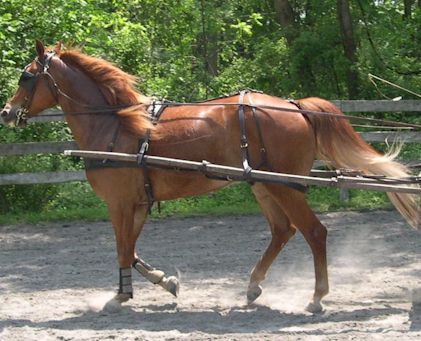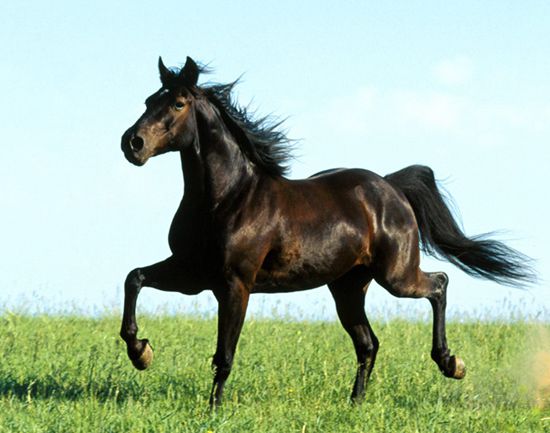
|
迪威国际在线客服-首页 |
|
|||
Products Category |
Trotter horseProduct name : Trotter horse Item : H-02 Details :The Missouri Fox Trotter is a horse breed from the state of Missouri in the United States. It was developed in the Ozark Mountains by settlers in the early 19th century, and quickly developed into a gaited breed appreciated for its stock horse abilities, stamina and smooth gaits. It performs an ambling gait known as the "fox trot", a four-beat broken diagonal gait in which the front foot of the diagonal pair lands before the hind, eliminating the moment of suspension and increasing smoothness. The main breed registry was begun in 1948 and as of 2012 registers almost 100,000 horses. A European registry was begun in 1992, and as of 2009 recognizes around 600 Fox Trotters living in Europe. In 2006, a smaller registry, focused on the preservation of the original, historic type, was begun in the United States. The Fox Trotter is a mid-sized, muscular breed, used mainly for trail riding and ranch work.
Missouri Fox Trotters stand 14 to 16 hands (56 to 64 inches, 142 to 163 cm) high, and weigh between 900 and 1,200 pounds (410 and 540 kg). Begun in 2004, the Missouri Fox Trotting Horse Breed Association also maintains a separate registry for fox trotting ponies standing between 11 and 14 hands (44 and 56 inches, 112 and 142 cm). Fox Trotters may be any solid color or pinto. White facial and leg markings are common. The facial profile is straight, set upon a neck of medium length than ends in pronounced withers. The breed is muscular, with sloped shoulders, a short back and sturdy legs. The Missouri Fox Trotter performs an ambling gait known as the "fox trot", which replaces the trot seen in many other breeds. The fox trot is a four-beat broken diagonal gait in which the front foot of the diagonal pair lands before the hind, eliminating the moment of suspension and giving a smooth, sure-footed ride. The gait is sometimes described as having the horse walk with the front feet and trot with the back. In a fox trot, the horse must keep one front foot on the ground at all times and display a sliding motion with the hind legs. The fox trot and the regular trot are both at a speed between a walk and a canter or gallop; ambling gaits are four-beat gaits, whereas the trot is a two-beat gait. The extra footfalls provide additional smoothness to a rider because the horse always has at least one foot on the ground. This minimizes movement of the horse's topline and removes the bounce of a two-beat gait, caused by a moment of suspension followed by the jolt of two feet hitting the ground as the horse shifts from one pair of legs to the other. The value of an intermediate speed is that the horse conserves energy. More than thirty horse breeds are "gaited," able to perform a four-beat ambling gait; some can also trot. A Missouri Fox Trotter, with rider, can maintain a speed of 5 to 8 miles per hour (8.0 to 13 km/h) while using the fox trot, and can cover short distances at up to 10 miles per hour (16 km/h). In comparison, the average medium trot speed is 6 to 8 miles per hour (9.7 to 13 km/h).
Missouri Fox Trotters are used extensively by trail riders, who appreciate their gaits, stamina and weight-carrying abilities. They are also used in handicapped riding programs, and their smooth gait has proven useful for riders with minor physical disabilities. Crosses between Fox Trotter mares and donkey jacks are often made, creating mules with the fox trot gait that are used to carry hunters and trail riders, especially in the western United States. The US Forest Service also employs Fox Trotters for their speed, stamina and gait, and members of the breed were used to make the first horse-back descent of the north rim of the Grand Canyon.
The Orlov Trotter is a horse breed with a hereditary fast trot, noted for its outstanding speed and stamina. It is the most famous Russian horse. The breed was developed in Russia in the late 18th century by Count Alexei Orlov at his Khrenovskoy Stud farm near the town of Bobrov (Voronezh guberniya) . The Orlovs emerged as the result of crossing various European mares (primarily of English, Dutch, Mecklenburg, and Danish breeding) with Arabian stallions.  Send Inquiry : |
Copyright © 2025 迪威国际在线客服-首页 All Rights Reserved


 Cattle
Cattle  Horse
Horse 
